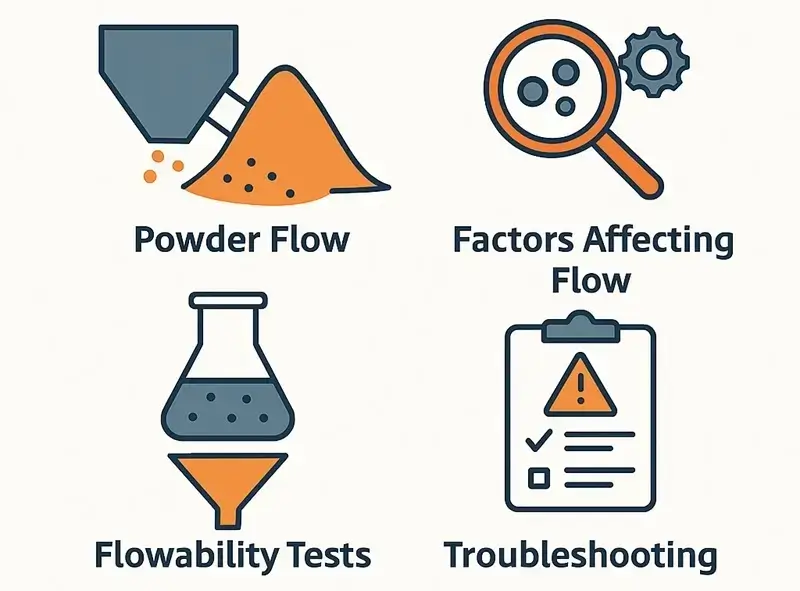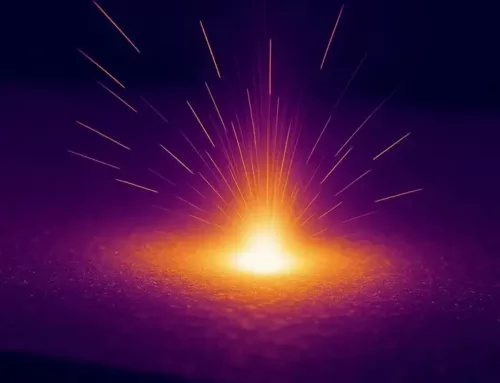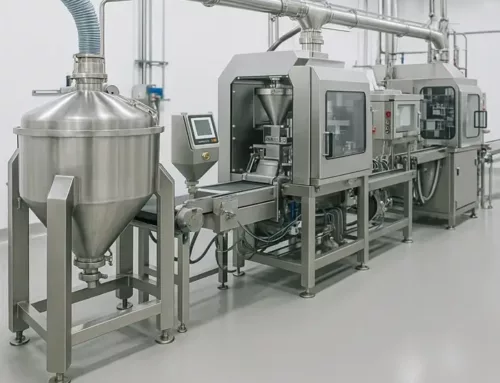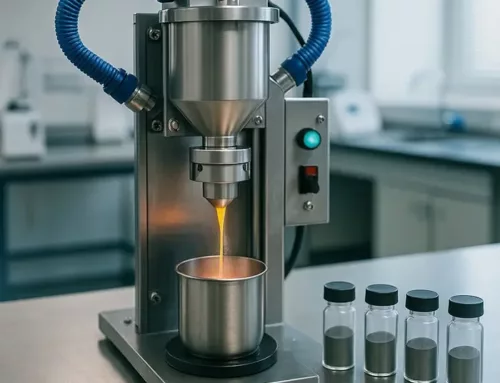Table of contents

Why Spheroidization Matters
Spherical particles behave differently. They flow cleanly, spread evenly, and stack into dense layers. In additive manufacturing, especially laser powder bed fusion (LPBF), this makes a measurable difference. You get fewer defects, tighter tolerances, and stronger parts.
Irregular powders, by contrast, clog, agglomerate, and scatter inconsistently. That leads to porosity, poor sintering, and uneven layers. For aerospace or implants, that margin of error isn’t acceptable.
As demand for titanium powders rises, 8.2 percent CAGR through 2030, the pressure grows to deliver better material at a lower cost. Gas atomized feedstocks still dominate the market, but they remain expensive. In aerospace-grade formats, prices can reach 250 dollars per kilogram. Laser spheroidization offers an alternative.
How Laser Spheroidization Works
The process is simple on paper. Irregular particles are exposed to intense laser energy, either in-flight or on a controlled platform. Energy densities reach over 100 megawatts per square meter. That’s enough to rapidly melt the particles.
While molten, surface tension pulls each droplet into a sphere. Inert gas jets then cool the particle quickly, locking the shape before any deformation occurs. That’s all it takes to reshape the material: heat, tension, and timing.
The benefits stack up. Satellite formation drops sharply. Purity improves, since volatile contaminants like chlorides or hydrides evaporate during the thermal cycle. Interstitial oxygen can drop below 0.15 weight percent, keeping the final product within aerospace specifications.
Operators can control particle size by adjusting laser power (500 to 2000 watts) and exposure time (2 to 10 milliseconds). That makes it easy to target the 15 to 45 micrometer range, right in the LPBF sweet spot.
Energy efficiency is another advantage. Laser spheroidization consumes 40 percent less energy per kilogram than plasma torches while boosting throughput by 25 percent. The method also works with HDH powders and recycled swarf, which expands its appeal.
What Modeling Tells Us
Researchers simulated the laser spheroidization of Ti-6Al-4V using Abaqus and OpenFOAM. Abaqus handled transient heat conduction with phase change. OpenFOAM manages fluid dynamics and internal flow behavior.
Thermal conductivity values ranged from 7.2 watts per meter-kelvin (solid) to 33 watts per meter-kelvin (liquid). Laser flux peaked at 94 megawatts per square meter, modeled as a Gaussian profile. Viscosity and surface tension dropped predictably with rising temperature. The mesh used adaptive refinement, and time steps stayed below CFL limits.
Marangoni flow—caused by temperature-driven surface tension gradients—created internal convection that helped the droplet round off quickly. Velocities reached up to two meters per second in the molten phase.
Phase transformation modeling used Scheil-Gulliver equations with Koistinen-Marburger corrections. Rapid cooling near 1000 degrees Celsius per second produced martensitic alpha-prime phases typical in laser-processed titanium.
Results Worth Noting
Simulations showed full spheroidization of Ti-6Al-4V powders between 20 and 80 micrometers in under five milliseconds. Smaller particles, especially below 30 micrometers, overheated. Temperatures exceeded 5000 degrees Celsius, resulting in up to 15 percent evaporation loss. Particles larger than 100 micrometers didn’t fully melt due to internal gradients.
The model predicted Marangoni-driven flows strong enough to round off droplets before cooling. That matched practical expectations but still needs experimental validation for peak flow velocity and surface finish.
Missing from the current literature are high-speed diagnostics and detailed microstructure data. Martensite content, oxide shell thickness, and hardness evolution all deserve more attention in real-world conditions.
What This Means in Production
Laser-spheroidized titanium powders perform well in LPBF. Hall flow times of 27 seconds per 50 grams and apparent densities over 4 grams per cubic centimeter are achievable. Powder layers can be recoated as thin as 20 micrometers with ±1.5 micrometer uniformity.
The part quality improves. In one case, micro-CT scans showed porosity dropping from 1.2 percent to 0.5 percent when switching to spheroidized powder in aerospace brackets. That translates directly to stronger, lighter parts.
Cost drops, too. HDH titanium powder treated with laser spheroidization costs about 80 dollars per kilogram. Compare that to 150–250 dollars for gas atomized material. Recyclability improves as well. Spheroidized powders remain usable for five or more LPBF cycles, while plasma-based feedstocks often degrade after just two or three.
Energy use drops to 18–22 kilowatt-hours per kilogram. Plasma systems consume 35–40. That difference alone cuts carbon emissions by about 45 percent per kilogram processed.
Quality Control and Safety
Safety must now align with NFPA 660 (2025 edition), which consolidates earlier combustible‑dust standards—including the former NFPA 484 for metal powders—into a unified code. Chapter 22 explicitly covers reactive metals such as titanium powder.
Feedstock must also comply with ASTM F3001‑14(2021) (Grade 23 Ti‑6Al‑4V ELI), which sets chemical tolerances and purity limits. That includes a maximum oxygen content of 0.2 wt %, Hall flow requirements, and interstitial limits typical of aerospace-grade powder use.
Plant engineering must include Class D dry‑metal fire extinguishers and explosion suppression systems. Facilities should operate under <10 ppm O₂ Argon atmospheres, maintain 15–25 % relative humidity, use ionized‑air curtains or conductive flooring to eliminate static risk, and conduct powder transfer in dedicated inert‑gas rooms. These controls reflect NFPA 660 Chapter 22 and ASTM F3001 guidelines on titanium powder reactivity control
Where the Technology Goes Next
Although medical and aerospace sectors already rely on laser spheroidization of titanium powders, demand continues evolving rapidly.
In fact, orthopedic implants now push for lattice structures with precise pore control, and pipeline expectations are rising accordingly.
Moreover, spherical CP‑Ti powders deliver better biological integration, yet next‑generation applications require alloy‑specific tuning to meet stricter parameters. To this end, engineers now match particle size distribution, purity levels, and flow behavior to precise implant geometries.
In parallel, aerospace manufacturing sees spheroidized Ti‑48Al‑2Cr‑2Nb replacing cast gamma‑TiAl turbine blades, reducing residual stress by over fifty percent.
Still, aluminum‑rich alloys, particularly Ti‑5553, continue to challenge the process window because vaporization remains a serious concern.
As a result, pulse‑modulated lasers and adaptive thermal profiles now evolve to reduce elemental loss while retaining alloy chemistry.
Meanwhile, real‑time thermal imaging combined with neural networks detects evaporation‑induced defects during production as they occur.
Consequently, this feedback loop improves consistency and will likely become standard in high‑spec powder production practices.
In addition, hybrid feedstocks coated with yttria‑stabilized zirconia now enter qualification for components operating above eight hundred degrees Celsius.
Conclusion and Outlook
aqaLaser spheroidization has gradually evolved from an experimental technique into a fully viable industrial process. Specifically for Ti-6Al-4V and other critical alloys, it delivers fast, controllable, and repeatable particle shaping. Therefore, it consistently outperforms conventional methods in cost, process consistency, and sustainability metrics across applications.
The path forward is not about replacing existing technologies immediately but instead about strategic adoption of laser spheroidization. Indeed, using this process smartly enables lowering the cost per kilo, extending recycled feedstock life, and meeting stricter tolerances in advanced builds. Thus, the process helps meet those tighter build requirements while ensuring performance consistency.
As feedstock demands continue to evolve and end-use applications grow more complex, this technology begins establishing itself as core infrastructure. Ultimately, it transforms from an optional technique into essential infrastructure within powder additive manufacturing workflows and standards.
FAQ laser spheroidization of titanium powders
Yes. Laser spheroidization of titanium powders enables circular use of HDH and recycled feedstock, reducing waste and energy consumption.
NFPA 660 Chapter 22 and ASTM F3001 define safety protocols, purity thresholds, and oxygen limits for laser‑spheroidized titanium powders.
It enhances powder flow, packing density, and part quality in LPBF by producing uniform spherical feedstock with predictable behavior.
Laser spheroidization of titanium powders consumes less energy, creates fewer satellite particles, and costs significantly less compared to gas atomization.
Laser spheroidization of titanium powders melts irregular particles with focused laser energy, then surface tension forms smooth spheres during rapid cooling.







